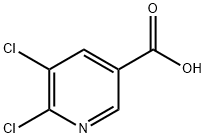|
|
| | 5,6-Dichloronicotinic acid Basic information |
| Product Name: | 5,6-Dichloronicotinic acid | | Synonyms: | 5,6-DICHLORO-3-PYRIDINECARBOXYLIC ACID;5,6-DICHLORONICOTINIC ACID;5,6-DICHLOROPYRIDINE-3-CARBOXYLIC ACID;TIMTEC-BB SBB003623;5,6-Dichloropyridine-3-carboxylicacid,96%;5,6-Dichloro;5,6-DICHLORONICOTINIC ACID 98+%;5,6-Dichloronicotinic acid, 5,6-Dichloropyridine-3-carboxylic acid | | CAS: | 41667-95-2 | | MF: | C6H3Cl2NO2 | | MW: | 192 | | EINECS: | 609-951-1 | | Product Categories: | Heterocycle-Pyridine series;Chloropyridines;Halopyridines;Pyridine;Building Blocks;C5 to C6;C6 to C7;Chemical Synthesis;Halogenated Heterocycles;Heterocyclic Building Blocks;Pyridines;pharmacetical;Organic acids;Pyridines, Pyrimidines, Purines and Pteredines;Intermediate | | Mol File: | 41667-95-2.mol |  |
| | 5,6-Dichloronicotinic acid Chemical Properties |
| Melting point | 164-168 °C(lit.) | | Boiling point | 342.1±37.0 °C(Predicted) | | density | 1.612±0.06 g/cm3(Predicted) | | storage temp. | Keep in dark place,Sealed in dry,Room Temperature | | solubility | DMSO (Slightly), Methanol (Slightly) | | pka | 2.87±0.10(Predicted) | | form | Powder | | color | White to beige to tan | | BRN | 383740 | | InChI | InChI=1S/C6H3Cl2NO2/c7-4-1-3(6(10)11)2-9-5(4)8/h1-2H,(H,10,11) | | InChIKey | RNRLTTNKVLFZJS-UHFFFAOYSA-N | | SMILES | C1=NC(Cl)=C(Cl)C=C1C(O)=O | | CAS DataBase Reference | 41667-95-2(CAS DataBase Reference) |
| Hazard Codes | Xi | | Risk Statements | 36/37/38 | | Safety Statements | 22-24/25-36-26 | | WGK Germany | 3 | | HazardClass | IRRITANT | | HS Code | 29339900 |
| | 5,6-Dichloronicotinic acid Usage And Synthesis |
| Chemical Properties | white to off-white crystalline powder | | Uses | 5,6-Dichloronicotinic acid is a dihalonicotinic acid. It is used in the preparation of 5-chloro-6-iodonicotinic acid by iodine displacement. | | Application | 5,6-Dichloronicotinic acid is a compound that can be synthesized by reacting methyl ketones with chloroacetic acid. It is used in the synthesis of maleic anhydride and has been shown to inhibit the catalysis of acetylcholine chloride. It has also been shown to have an inhibitory effect on Alzheimer's disease. The kinetic mechanism for this inhibition occurs through the hydrolysis step of 5,6-Dichloronicotinic acid by magnesium chloride in hexane solution. The reactive acylation reaction proceeds when it reacts with acetic anhydride in the presence of pyridine. | | Synthesis | The general procedure for the synthesis of 5,6-dichloropyridine-3-carboxylic acid from 5,6-dichloronicotinic acid ethyl ester was as follows: in a solvent mixture of tetrahydrofuran (THF), methanol (MeOH) and water (50 mL, 4:1:1, v/v/v), ethyl 5,6-dichloronicotinic acid ethyl ester (1.0 g, 4.5 mmol) and aqueous sodium hydroxide 2N solution (6.75 mL, 13.5 mmol). The reaction mixture was stirred at room temperature for 0.5 hours. Upon completion of the reaction, the mixture was concentrated to remove the organic solvent. Subsequently, the mixture was acidified with 2N hydrochloric acid to a pH of about 2. The acidified mixture was extracted with ether (30 mL x 3). The organic layers were combined, washed with water (50 mL x 3), dried over anhydrous sodium sulfate, and concentrated to give 5,6-dichloropyridine-3-carboxylic acid (800 mg, 91% yield) as a white solid.LCMS (ESI) m/z: 192.0 [M + H]+. | | References | [1] Patent: US2013/317000, 2013, A1. Location in patent: Paragraph 0368-0369 |
| | 5,6-Dichloronicotinic acid Preparation Products And Raw materials |
|